The 10 Most Important Players to the Vikings’ Future
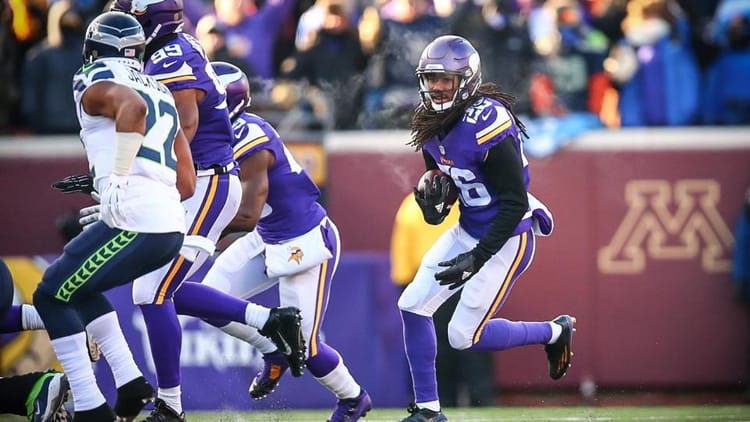
This time of year, with the Scouting Combine just wrapping up and the Draft rapidly approaching, we spend a lot of time focusing on the future. The Vikings are coming off an 11-5, division championship season, and look to be firmly headed in the right direction. So, before any draft picks or free agency additions, I thought it was a good time to look at the future within the organization. Below is a countdown of the 10 most important players to the Vikings’ future:
(NOTE: This list only includes players currently on the team’s roster. It takes into account skill level, positional importance, age, contract, and the team’s investment in the player. It’s more than a list of best players; rather, it focuses on who will be counted on to play major roles in the next five to eight years if the team is to continue to compete for division championships and playoff berths. For example, a player who is talented and productive but approaching the end of his career would be given less consideration than a young, high draft pick who has shown good ability in a short time.)
10. Sharrif Floyd
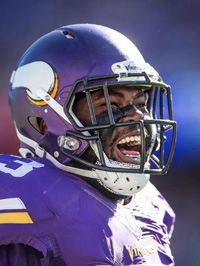
Image courtesy of Vikings.com
In his three seasons in the league, Floyd has been about as quiet as a first round pick can be. That’s less of a knock on him than an acknowledgement of the solid (if unspectacular) impact he’s had on the team; Floyd hasn’t made a boatload of big, splashy plays, but he rarely gets moved far off the point of attack. Overall, he’s been a good, not great, cog in the middle of the defensive line.
Floyd makes the list because he’s only 24 and plays an important position next to Linval Joseph when it comes to rushing the passer AND stopping the run. His rookie deal is up after 2016, but it’s unlikely he’ll leave via free agency—he’s valuable enough for the team to prioritize retaining him, but shouldn’t command unreasonable money on the open market. Floyd posted 34 tackles and 2.5 sacks in 2015, but stats rarely tell the whole story with interior linemen. He should continue to make the Vikings’ defensive front one of the league’s best for years to come.
9. Blair Walsh
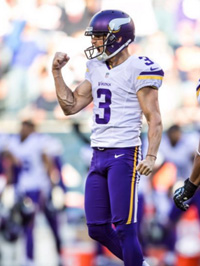 2016 will be an important year for Blair Walsh. Following the miss heard round the world in the divisional playoffs, it’s up to Walsh to regain his confidence and return to the form that has made him one of the best kickers in the NFL for the better part of his career. After a miss like that, it could go either way; a defining bounce back the following year or a career plagued with big-spot failures. 2016 will give us an idea which way it will go.
2016 will be an important year for Blair Walsh. Following the miss heard round the world in the divisional playoffs, it’s up to Walsh to regain his confidence and return to the form that has made him one of the best kickers in the NFL for the better part of his career. After a miss like that, it could go either way; a defining bounce back the following year or a career plagued with big-spot failures. 2016 will give us an idea which way it will go.
Before last season, Walsh signed a 4 year, $13 million contract with the Vikings, a sizeable investment for the team. He just turned 26—young for a kicker—and has many years of ahead of him, provided he shakes off the playoff failure and kicks like he’s capable. If he does, he will finish his career in Minnesota.
8. Jerick McKinnon
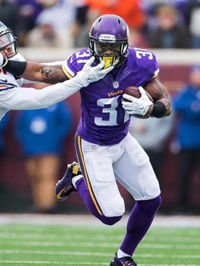
Image courtesy of Vikings.com
For the 23-year-old running back, the next two seasons will be interesting. He’s shown impressive vision and quickness in limited action behind Adrian Peterson, and it’s hard to tell exactly how his small frame (5’9”, 205 lbs) would handle a full workload. But McKinnon has averaged 4.9 yards per carry in his two-year career, and rushed for 538 yards on 113 attempts when the Vikings were without Peterson in 2014.
“Full workload” doesn’t mean what it used to for an NFL running back, with teams now commonly opting to split carries between two or three backs. With the Vikings slowly shifting toward a more pass-centric offense to utilize Teddy Bridgewater, and Adrian Peterson’s days with the team (and, perhaps, in the league) numbered, McKinnon will likely end up the lead back at some point. While the position has been marginalized in recent years, it’s still vitally important to the rushing AND receiving output of a successful offense.
7. Stefon Diggs
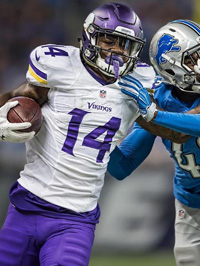
Image courtesy of Vikings.com
There’s been considerable discussion about whether or not Diggs is a number one receiver, but regardless of the answer, Diggs had a sensations rookie season for a fifth-round draft pick. His stat line—52 catches, 720 yards, and 4 touchdowns in just 13 games—compares favorably with the first year stats of many of the best receivers in the NFL, and Diggs can make highlight plays like few Vikings receivers in the past decade. He should be, at the very least, a solid target in the passing game, and Diggs’ ceiling is far greater than that.
As a fifth-round pick, Diggs is signed through 2019 with an average annual salary of just over $600,000, a steal for a player of his caliber.
6. Harrison Smith
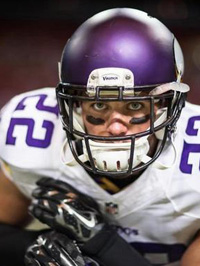
Image courtesy of Vikings.com
Harry the Hitman is 27 years old and in the prime of his career. While his contract expires after next season, the Vikings are a virtual lock to give Smith an extension (and a sizeable raise). He’s been an anchor and a playmaker in the secondary since his rookie year, and a much-needed stabilizing force in the back of the defense. Smith made his first career Pro Bowl last season.
If the team is to continue its defensive dominance, they’ll be counting on Smith to keep doing his thing. It’s common for fans to lament the uneven (and often atrocious) play at the other safety spot, but they should also be thankful they at have Harrison Smith.
5. Eric Kendricks
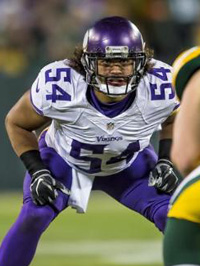
Image courtesy of Vikings.com
As a second-round draft pick, Kendricks played a whopping 71% of the team’s defensive snaps in 2015, and provided an added spark to the linebacking corps. Kendricks quickly supplanted Gerald Hodges as a starter, allowing the team to trade him to San Francisco. Kendricks played the middle linebacker position as a rookie, but the team sees him as an ideal fit on the weak side, and will likely move him there when Chad Greenway is done with the Vikings.
With 92 combined tackles and 4 sacks as a rookie, Kendricks should take a step next season, and is signed through 2019.
4. Trae Waynes
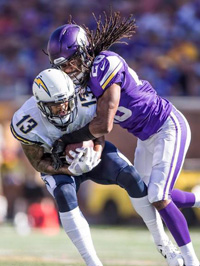
Image courtesy of Vikings.com
Waynes played just 18% of the team’s defensive snaps in 2015, with Mike Zimmer opting to play more established veterans over the rookie the majority of the time. Still, Waynes played reasonably well when he did see the field, and will likely see his role expand considerably in 2016 (especially if Terence Newman isn’t back).
This ranking is much more about the Vikings’ investment in Waynes than his production to this point. As not only a first-round draft pick, but a high one (number 11), the team can’t afford to have Waynes be anything other than a starter at corner. They’re bringing him along slowly thus far, but before long, the kid gloves will come off and Waynes will be given a good deal of responsibility. With the pass-centric way the league is going, cornerback is one of the most vital positions on defense, and high first round draft picks are expected (and needed) to lock down top receivers. Anything other than above average play in the long run would be a failure for Waynes, and would set the Vikings back considering their investment. He has the talent to be a very good player, and in Zimmer’s defense, it’s a good bet he will be.
3. Danielle Hunter
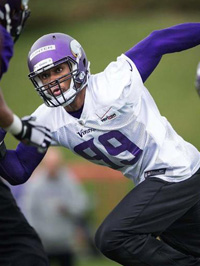
Image courtesy of Vikings.com
21 years old, unlimited potential. Hunter was the youngest player in the NFL last season, and after being called “raw” and a “project” coming out of LSU, he was drafted in the third round and immediately showed flashes. As the season wore on, Hunter got on the field more often and started looking like a force on defense; he had six sacks as a rookie and got consistent pressure on the quarterback near year’s end.
At 6’5”, 252 lbs, Hunter is a long, rangy, elite athlete, one tailor made to rush the passer in today’s NFL. And pass rushers have never been more important—the Denver Broncos won both the AFC Championship game and the Super Bowl largely due to their excellent pass rush. Hunter will see more playing time in 2016, and it wouldn’t be surprising to see him supplant starter Brian Robison before long. Mike Zimmer has already started molding him into the player he wants, and a few more years under the defensive mastermind could have Hunter turning out Watt-esque sack numbers. Buckle up, Vikings fans.
2. Anthony Barr
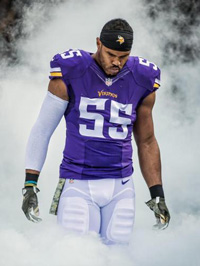
Image courtesy of Vikings.com
When Barr was drafted ninth overall in 2014, fans greeted the pick with mixed reactions and healthy skepticism. Most envisioned Barr as primarily an edge rusher, so his fit as a 4-3 linebacker was unclear. Two seasons later, that skepticism is gone. Barr immediately showed he was more than a pass rusher, and has developed into an all-around standout who excels equally against the run, rushing the passer, and in coverage. In 2015, he was Pro Football Focus’s second-highest rated linebacker behind Luke Kuechly.

via Pro Football Focus
Barr hasn’t produced eye-popping stats, but he affects the game in numerous areas that don’t show up in the box score. He has ideal size and lateral quickness, and has an uncanny ability to run down ballcarriers. Barr is also one of the best tacklers on the Vikings defense. In short, he’s the total package at linebacker. Almost every historically elite defense has one linebacker who dominates against both the run and the pass. Anthony Barr is that guy.
1. Teddy Bridgewater
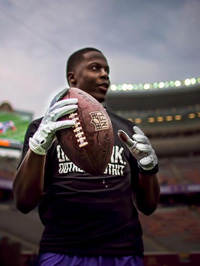
Image courtesy of Vikings.com
Not much suspense at number one. At the most important position in sports, the Vikings finally have long-term hope, and his name is Teddy. Bridgewater’s first two seasons have been up and down, and if there’s a knock on him so far, it’s that he’s too careful with the ball and commonly checks down rather than looking for the big play. Still, the 65% completion percentage is a welcome change from the Ponder years, and the kid has the look of the real deal; poise, toughness, and occasional fourth quarter heroics, plus his teammates and coaches love him.
The truth is, if this things is going to work—if the Vikings are going to win more division championships and get past the first round of the playoffs—it’s going to be on Teddy’s shoulders. The nature of the quarterback position is such that having a good one can mask a host of other problems (e.g. Tom Brady, Aaron Rodgers), and a team that’s otherwise loaded can see its hopes derailed by poor quarterback play (the 2014 Cardinals, the Kyle Boller-era Ravens, and Tarvaris Jackson’s Vikings, among many others). The quarterback simply has to play well for a team to succeed in the NFL; there’s no way around it. Bridgewater has shown signs he can be the guy, and while it’s far from a sure thing at this point, when it comes to who’s most important to the team’s future, he’s number one with a bullet.

You must be logged in to post a comment.